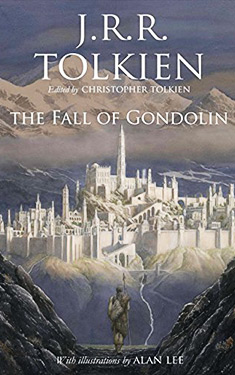JRR Tolkien
Completed 1/16/2019,
Reviewed 1/16/2019
4 stars
The Fall of
Gondolin is the third in the stories of the First Age that Tolkien thought were
central to his mythology. It recounts
the fall of the last stronghold of the Elves in Middle Earth at the hand of
Morgoth. This volume is like Beren and Luthien in that it is not one continuous story, but a collection of the
versions of it that Tolkien wrote over the course of his life. Unlike its predecessor, I found it much more
interesting and satisfying, probably because I have not read quite as many
versions of it. Although I was familiar
with the story, its retellings felt fresh, and the different versions added and
subtracted enough to make each one interesting.
 The story
follows Tuor, the son of Huor, brother of Hurin, father of Turin Turambar. So Tuor and the hero of The Children of Hurin
are cousins. Living as an outlaw, he
follows a river west to the sea. There Ulmo,
god of the waters, and second in power to Manwe, appears to him. Ulmo tells Tuor to go to the hidden city of
Gondolin to warn the elves to fight against Morgoth now before Morgoth discovers
and destroys Gondolin. He gives Tuor an
elf companion who knows the secret entrance.
They journey to Gondolin and warn Turgon the king, but Turgon refuses
the information, relying on the council of his evil nephew. Tuor nonetheless stays in Gondolin, marries Idril,
the king’s daughter, and has a son Earendil, the hero of the end of the First
Age. This is the second known marriage
of a man with an elfmaiden. Morgoth
eventually discovers the location of Gondolin and invades.
The story
follows Tuor, the son of Huor, brother of Hurin, father of Turin Turambar. So Tuor and the hero of The Children of Hurin
are cousins. Living as an outlaw, he
follows a river west to the sea. There Ulmo,
god of the waters, and second in power to Manwe, appears to him. Ulmo tells Tuor to go to the hidden city of
Gondolin to warn the elves to fight against Morgoth now before Morgoth discovers
and destroys Gondolin. He gives Tuor an
elf companion who knows the secret entrance.
They journey to Gondolin and warn Turgon the king, but Turgon refuses
the information, relying on the council of his evil nephew. Tuor nonetheless stays in Gondolin, marries Idril,
the king’s daughter, and has a son Earendil, the hero of the end of the First
Age. This is the second known marriage
of a man with an elfmaiden. Morgoth
eventually discovers the location of Gondolin and invades.
The first
presentation of the story is like Beren and Luthien, full of archaic English
words and form. It is not easy reading,
but you get the general gist of the story.
Then you get later versions of the story written in much more
contemporary English and it all comes together.
Unfortunately, you never get one complete story in modern English. But for me it all came together rather
cohesively in my head. The prose of the
modern English is terrific. There isn’t
much dialogue, as is true of much of the First Age tales, but what’s there is
beautifully written. The description of
the seven gates at the entrance to Gondolin is simply mesmerizing.
In addition
to the basic story of Gondolin, Christopher Tolkien also provides the continuation
of the story which follows Earendil to the end of the First Age and the
prophesy of the end of all things.
Tolkien never wrote any detailed stories of Earendil, so in these
passages, we just get summaries of his doings.
What we do get is fanciful and entertaining.
I give this
book four stars out of five. It is more accessible
than its predecessor. The only part I
didn’t care for was the evolution of the story.
I found Christopher Tolkien’s explanations a little drier than usual. This was perhaps because I was so engaged by
the story, I just wanted more of that.
No comments:
Post a Comment